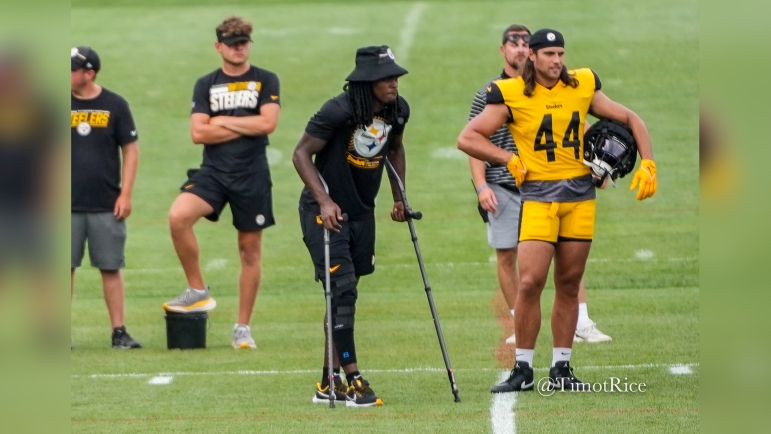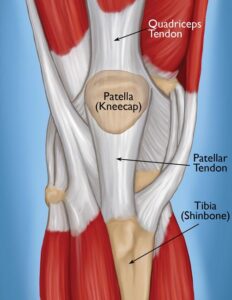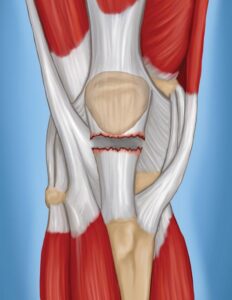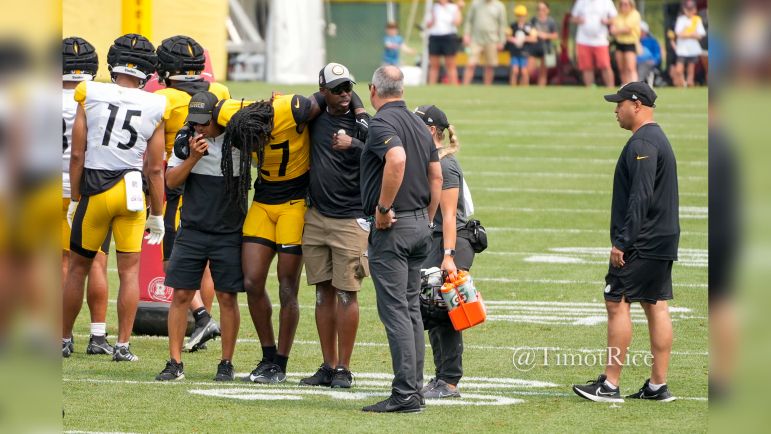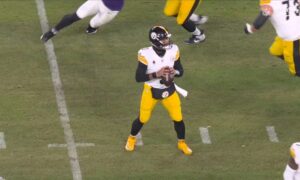Heading into the 2023 Pittsburgh Steelers training camp, fans were excited to see CB Cory Trice Jr, a seventh-round pick many considered the steal of the draft. Despite his talent and athletic ability, his draft stock had been impacted by his injury history. In the first five days of practice, he showed promise. That unfortunately came to a screeching halt during the first padded practice last Tuesday when Trice went down with an injury. He appeared to be in a lot of pain, both physical and mental, as he was carted off the field with his head in his hands. No stranger to injuries, it appeared that he already knew how bad this was.
It turned out he was right. The following day, the team placed him on the Reserve/Injured list, ending his rookie season. Without a chance to be on the 53-man roster, he has no opportunity to return from IR.
Since then, there have been no updates. The team has no obligation to provide injury updates for players on IR, but further detail is usually available in some form. Not this time. Trice, his brother, and mother have been silent on social media. There have been no reports from NFL insiders like Ian Rapoport or Adam Schefter, which isn’t all that surprising for a late-round draft pick. We don’t know much but with the little information we have, I can make a few educated guesses.
Let’s start with the facts:
— Trice was seen being helped onto the cart and could not put weight on his right leg.
— The injury was described after practice that day by HC Mike Tomlin as a “non-contact injury.”
— The following day, Tomlin described it as a “significant knee injury.”
— Trice was seen at practice on Saturday, four days after the injury, with a brace on his right leg and on crutches but bearing weight on the right leg.
— Trice has a history of left ankle fracture (did not require surgery) and left ACL repair but no known right leg injuries.
Any NFL fan will automatically assume that an injury described as a non-contact knee injury is an ACL tear. And that may very well be what happened to Trice. There are also other possibilities, so let’s look at them.
ACL Tear
An ACL tear is obviously the most likely diagnosis. If that’s the case, we can assume that Trice hasn’t had surgery yet because he was seen bearing weight on his right leg at practice. While many surgeons allow patients to bear some weight on the affected leg after ACL repair, it’s very unlikely that Trice would already be back on the sidelines so soon after surgery. It’s not unusual for a surgeon to wait several days for the swelling to go down prior to surgery. If Trice does, in fact, have an ACL tear, he should be undergoing surgery sometime next week.
In this scenario, there is every reason to be optimistic. Trice has already recovered from a left ACL tear and repair, so he knows the rehab process and we can expect that he will have a full recovery from this new knee injury since it is the other leg. Sustaining the injury as early in the preseason as he did, he may be ready to participate in OTAs next spring and should be cleared for full activity in time for training camp in 2024. In the meantime, he can participate in team meetings and observe practices, learning from the sidelines as WR Calvin Austin III did last season.
Patellar Tendon Tear
A full tear of the tendon that attaches the patella (kneecap) to the tibia (shinbone) is a less common non-contact knee injury. This can occur when landing from a jump with the knee bent and the foot planted. It can also occur as the final straw when the tendon has been weakened by inflammation over time. In some cases, a small fragment of bone can break off from the bottom of the patella, separating the tendon from the bone. With a full patellar tear, the patella is often displaced higher on the leg above the knee since it is no longer anchored to the tibia below the knee.
Here’s a schematic of the anatomy with and without a patellar tear:
A small partial tear may heal without surgery. A full-thickness tear always requires surgical repair.
A full patellar tendon tear seems less likely for a couple of reasons. First, most orthopaedic surgeons recommend operating quickly after the injury before the tendon scars down and the patella gets farther retracted up the thigh. If that were the case, Trice would not be visiting with his teammates already. Second, based on this photo from our own Tim Rice, the patella is in normal position:
A full-thickness patellar tear requiring surgical repair would be a tougher recovery long-term for a cornerback. Trice could still be ready to go by training camp next year, but historically NFL players do not have a high success rate of returning to their former level of play following this repair. There are always exceptions, as Chargers CB J.C. Jackson hopes to prove this year. And that data is a few years old based on the NFL databases while surgical and rehabilitation techniques continue to evolve and improve.
Other Ligament Tears
An isolated MCL tear rarely requires surgery, and the recovery time of four to six weeks would not have resulted in Trice going to IR, so we can safely rule that out. A combined ligament injury involving multiple ligaments is possible. In 2015, Le’Veon Bell sustained an MCL/PCL injury, requiring surgery and costing him the rest of the season. He rushed for 1,268 yards with another 616 yards receiving during the regular season the following year, showing no signs of lingering effects. If this was the situation for Trice, he could easily have the same successful return.
Patellar Dislocation
In this injury, the patella is usually displaced laterally, which can result when the foot is planted and a rapid change of direction or twisting occurs. The first step is to relocate the patella into its normal anatomic position. Given the time that Trice was down on the ground with the trainers, this is a possibility. In this scenario, there would not have been an obvious deformity of the knee by the time he stood up.
Unless patellar dislocations are recurrent, surgery is not necessary, as Chiefs fans know from QB Patrick Mahomes. If, however, an associated injury occurs to the knee ligaments or bone fragments become dislodged with the injury, surgery may be necessary. The recovery is faster than either an ACL or patellar tendon repair. In this situation, Trice would likely be cleared for full activity in several months, depending on the extent of surgery.
Other knee injuries, like a patellar fracture, are very unlikely because they almost always occur from some form of contact or collision.
Final Thoughts
Even without knowing the details of Trice’s injury, it is clear that the team believed it was significant enough that he would not recover in time to have a chance to make the final 53-man roster. Even if he could have resumed practice in a few months, it will always be harder for a rookie than a veteran to jump on the proverbial moving train.
Without the social media posts we have come to expect from players, especially the photos in pre-op or post-op, we may never know more about Cory Trice Jr’s knee injury. Or it may take a while. When RB Najee Harris injured his foot early in training camp last year, Tomlin stated that Najee’s foot had been stepped on. It was months later that Harris finally described it as a Lisfranc injury. Whatever Trice’s knee injury is, here’s hoping he can recover fully and show his team and the fans his true potential in 2024.
“Melanie H. Friedlander, M.D., F.A.C.S. is a doctor at Association of South Bay Surgeons in Torrance, California. Dr. Friedlander enjoys all aspects of general surgery, but her primary areas of focus are breast surgery and advanced laparoscopic surgery. She recently adopted an advanced, minimally invasive technique that reduces scar size in thyroid surgery. Dr. Friedlander is a member of the Society of American Gastrointestinal Endoscopic Surgeons (SAGES) and the Society of Laparoscopic Surgeons. She developed and published many scientific studies in highly esteemed medical journals.”

